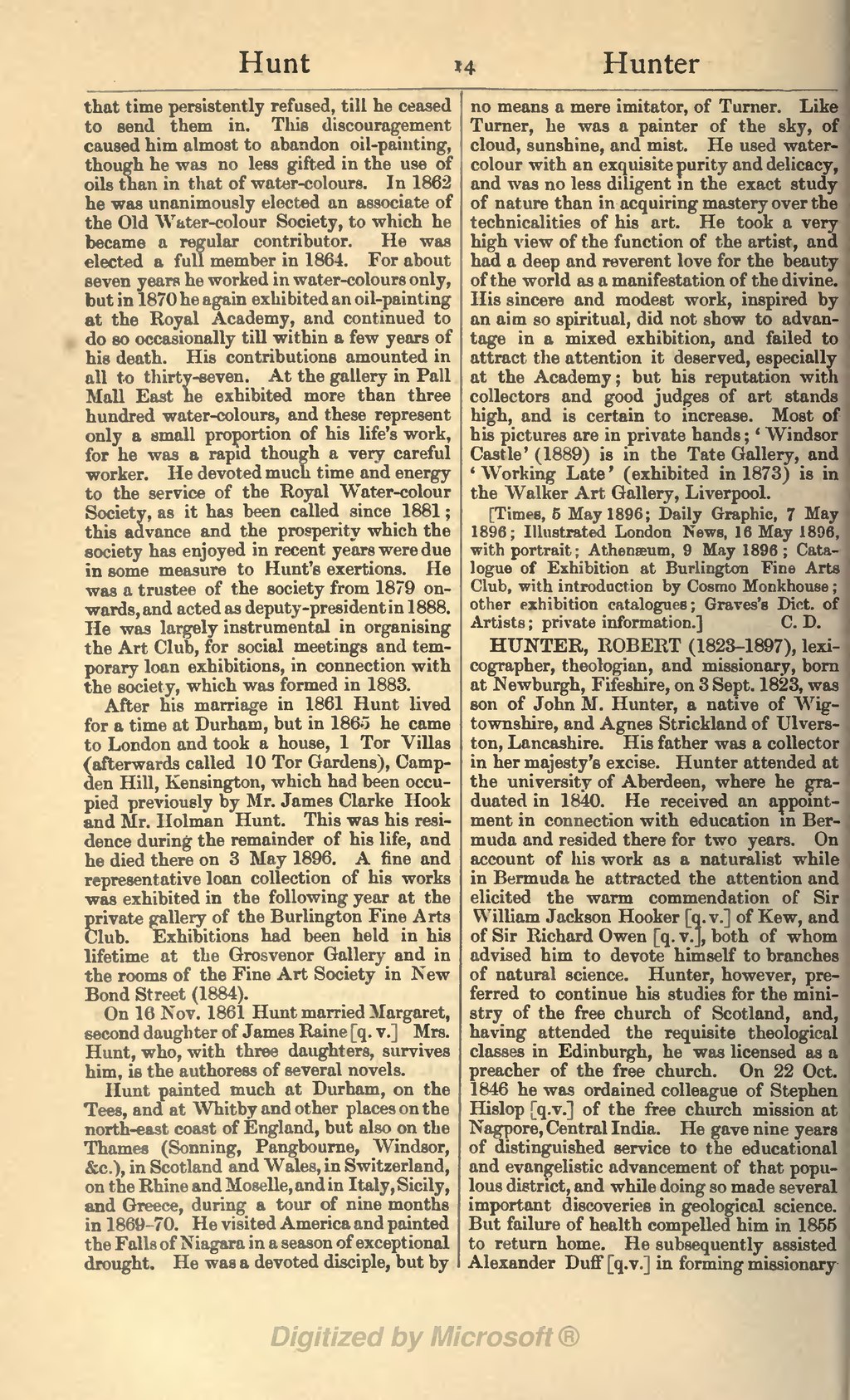that time persistently refused, till he ceased to send them in. This discouragement caused him almost to abandon oil-painting, though he was no less gifted in the use of oils than in that of water-colours. In 1862 he was unanimously elected an associate of the Old Water-colour Society, to which he became a regular contributor. He was elected a full member in 1864. For about seven years he worked in water-colours only, but in 1870 he again exhibited an oil-painting at the Royal Academy, and continued to do so occasionally till within a few years of his death. His contributions amounted in all to thirty-seven. At the gallery in Pall Mall East he exhibited more than three hundred water-colours, and these represent only a small proportion of his life's work, for he was a rapid though a very careful worker. He devoted much time and energy to the service of the Royal Water-colour Society, as it has been called since 1881; this advance and the prosperity which the society has enjoyed in recent years were due in some measure to Hunt's exertions. He was a trustee of the society from 1879 onwards, and acted as deputy-president in 1888. He was largely instrumental in organising the Art Club, for social meetings and temporary loan exhibitions, in connection with the society, which was formed in 1883. After his marriage in 1861 Hunt lived for a time at Durham, but in 1865 he came to London and took a house, 1 Tor Villas (afterwards called 10 Tor Gardens), Campden Hill, Kensington, which had been occu- pied previously by Mr. James Clarke Hook and Mr. Holman Hunt. This was his resi- dence during the remainder of his life, and he died there on 3 May 1896. A fine and representative loan collection of his works was exhibited in the following year at the private gallery of the Burlington Fine Arts Club. Exhibitions had been held in his lifetime at the Grosvenor Gallery and in the rooms of the Fine Art Society in New Bond Street (1884).
On 16 Nov. 1861 Hunt married Margaret, second daughter of James Raine [q. v.] Mrs. Hunt, who, with three daughters, survives him, is the authoress of several novels. Hunt painted much at Durham, on the Tees, and at Whitby and other places on the north-east coast of England, but also on the Thames (Sonning, Pangbourne, Windsor, &c.), in Scotland and Wales, in Switzerland, on the Rhine and Moselle, and in Italy, Sicily, and Greece, during a tour of nine months in 1869-70. He visited America and painted the Falls of Niagara in a season of exceptional drought. He was a devoted disciple, but by no means a mere imitator, of Turner. Like Turner, he was a painter of the sky, of cloud, sunshine, and mist. He used watercolour with an exquisite purity and delicacy, and was no less diligent m the exact study of nature than in acquiring mastery over the technicalities of his art. He took a very high view of the function of the artist, and had a deep and reverent love for the beauty of the world as a manifestation of the divine. His sincere and modest work, inspired by an aim so spiritual, did not show to advantage in a mixed exhibition, and failed to attract the attention it deserved, especially at the Academy; but his reputation with collectors and good judges of art stands high, and is certain to increase. Most of his pictures are in private hands; 'Windsor Castle' (1889) is in the Tate Gallery, and 'Working Late' (exhibited in 1873) is in the Walker Art Gallery, Liverpool.
[Times, 5 May 1896; Daily Graphic, 7 May 1896; Illustrated London News, 16 May 1896, with portrait ; Athenaeum, 9 May 1896; Catalogue of Exhibition at Burlington Fine Arts Club, with introduction by Cosmo Monkhouse ; other exhibition catalogues ; Graves's Dict. of Artists ; private information.]
HUNTER, ROBERT (1823–1897), lexicographer, theologian, and missionary, born at Newburgh, Fifeshire, on 3 Sept. 1823, was son of John M. Hunter, a native of Wigtownshire, and Agnes Strickland of Ulverston, Lancashire. His father was a collector in her majesty's excise. Hunter attended at the university of Aberdeen, where he graduated in 1840. He received an appointment in connection with education in Bermuda and resided there for two years. On account of his work as a naturalist while in Bermuda he attracted the attention and elicited the warm commendation of Sir William Jackson Hooker [q.v.] of Kew, and of Sir Richard Owen [q.v.], both of whom advised him to devote himself to branches of natural science. Hunter, however, preferred to continue his studies for the ministry of the free church of Scotland, and, having attended the requisite theological classes in Edinburgh, he was licensed as a preacher of the free church. On 22 Oct. 1846 he was ordained colleague of Stephen Hislop [q.v.] of the free church mission at Nagpore, Central India. He gave nine years of distinguished service to the educational and evangelistic advancement of that populous district, and while doing so made several important discoveries in geological science. But failure of health compelled him in 1855 to return home. He subsequently assisted Alexander Duff [q.v.] in forming missionary
